2017年牛津译林版英语1A全册教案
牛津译林版必修第一册--unit-1-reading教学设计-优秀教案
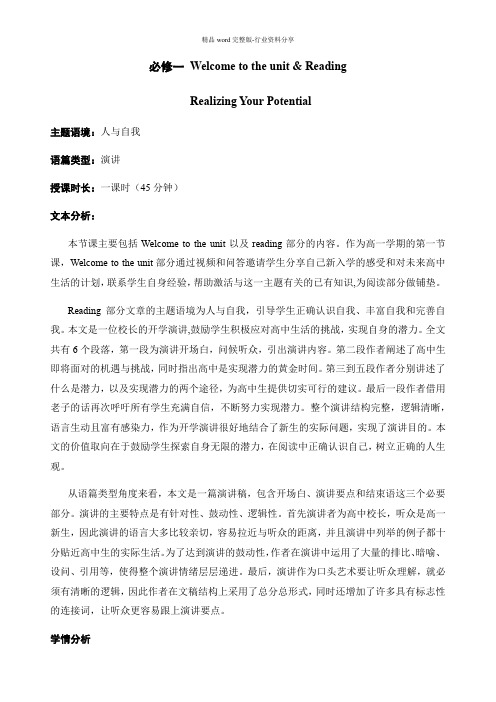
必修一Welcome to the unit & ReadingRealizing Your Potential主题语境:人与自我语篇类型:演讲授课时长:一课时(45分钟)文本分析:本节课主要包括Welcome to the unit以及reading部分的内容。
作为高一学期的第一节课,Welcome to the unit部分通过视频和问答邀请学生分享自己新入学的感受和对未来高中生活的计划,联系学生自身经验,帮助激活与这一主题有关的已有知识,为阅读部分做铺垫。
Reading部分文章的主题语境为人与自我,引导学生正确认识自我、丰富自我和完善自我。
本文是一位校长的开学演讲,鼓励学生积极应对高中生活的挑战,实现自身的潜力。
全文共有6个段落,第一段为演讲开场白,问候听众,引出演讲内容。
第二段作者阐述了高中生即将面对的机遇与挑战,同时指出高中是实现潜力的黄金时间。
第三到五段作者分别讲述了什么是潜力,以及实现潜力的两个途径,为高中生提供切实可行的建议。
最后一段作者借用老子的话再次呼吁所有学生充满自信,不断努力实现潜力。
整个演讲结构完整,逻辑清晰,语言生动且富有感染力,作为开学演讲很好地结合了新生的实际问题,实现了演讲目的。
本文的价值取向在于鼓励学生探索自身无限的潜力,在阅读中正确认识自己,树立正确的人生观。
从语篇类型角度来看,本文是一篇演讲稿,包含开场白、演讲要点和结束语这三个必要部分。
演讲的主要特点是有针对性、鼓动性、逻辑性。
首先演讲者为高中校长,听众是高一新生,因此演讲的语言大多比较亲切,容易拉近与听众的距离,并且演讲中列举的例子都十分贴近高中生的实际生活。
为了达到演讲的鼓动性,作者在演讲中运用了大量的排比、暗喻、设问、引用等,使得整个演讲情绪层层递进。
最后,演讲作为口头艺术要让听众理解,就必须有清晰的逻辑,因此作者在文稿结构上采用了总分总形式,同时还增加了许多具有标志性的连接词,让听众更容易跟上演讲要点。
【新文案】2017年牛津译林版英语1A全册教案

小学英语备课用笺●课题Unit1 Hello ●使用 1 课时●总第 1 课时●教学目标1.能听懂、会说日常问候语Hello!Hi!I’m 要求发音准确、语调自然。
2.能听懂、会说人物姓名Liu Tao Yang Ling3. 能听懂 Miss, Stand up.●教学重点难点教学重点:1.能听懂、会说日常问候语Hello!Hi!I’m 要求发音准确、语调自然。
2.能听懂、会说人物姓名Liu Tao Yang Ling教学难点:能用I’m 做自我介绍●教学具准备及辅助活动图片,多媒体●主要板书计划Unit 1 HelloHi/Hello I’m Liu TaoYang Ling●作业设计、安排课内练习 Hel lo/ Hi I’m… 课外让学生和家长问好,以巩固所学的Hello,Hi。
●教学过程教学随笔Step1 Warm UpT: hi, boys and girls.Ss: hi。
T: 同学们,我们要开始上课了。
大家要一起说stand up。
起立。
学习stand up。
(t-an, s, d, stand)(u, p, up)T: class begins.Ss: stand up.T: hi!Ss: hi!Repeat 3 timesStep 2 presentation1.T: Hi!与学生打招呼,并热情的挥手。
引导同学也用Hi来回答。
T; hi!Ss: hi!学习hi!学生齐读2..t-s1:Hi!S1: hi!T: can you speak to s2? 你能用hi和你后面的同学打招呼吗?S1-s2: hi!S2-s1: hi!3. t-s1: hi!S1:hi!t-s2: hello!引导学生也用hello来回答学习hello!学生齐读。
4.用hi hello与同学随机打招呼。
并进行pair work, 同桌间练习请同学来进行表演。
及时表扬。
5. t: (自我介绍)Hello! I’m Miss G. 学习I’m 和Miss学生齐读。
译林版牛津A全册教案
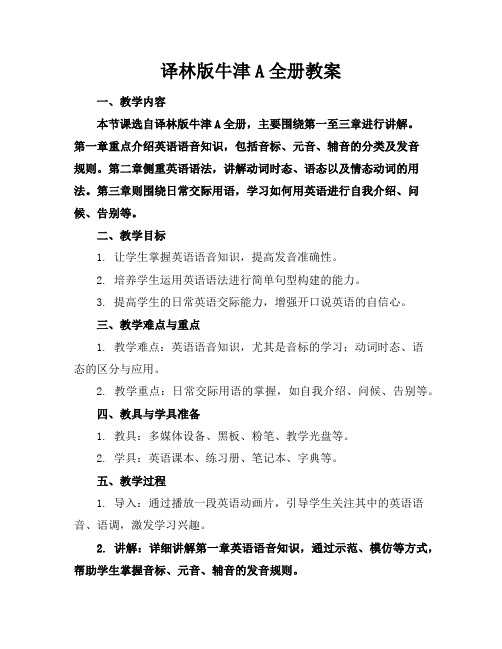
译林版牛津A全册教案一、教学内容本节课选自译林版牛津A全册,主要围绕第一至三章进行讲解。
第一章重点介绍英语语音知识,包括音标、元音、辅音的分类及发音规则。
第二章侧重英语语法,讲解动词时态、语态以及情态动词的用法。
第三章则围绕日常交际用语,学习如何用英语进行自我介绍、问候、告别等。
二、教学目标1. 让学生掌握英语语音知识,提高发音准确性。
2. 培养学生运用英语语法进行简单句型构建的能力。
3. 提高学生的日常英语交际能力,增强开口说英语的自信心。
三、教学难点与重点1. 教学难点:英语语音知识,尤其是音标的学习;动词时态、语态的区分与应用。
2. 教学重点:日常交际用语的掌握,如自我介绍、问候、告别等。
四、教具与学具准备1. 教具:多媒体设备、黑板、粉笔、教学光盘等。
2. 学具:英语课本、练习册、笔记本、字典等。
五、教学过程1. 导入:通过播放一段英语动画片,引导学生关注其中的英语语音、语调,激发学习兴趣。
2. 讲解:详细讲解第一章英语语音知识,通过示范、模仿等方式,帮助学生掌握音标、元音、辅音的发音规则。
3. 实践:分组进行语音练习,让学生互相纠正发音,提高发音准确性。
4. 例题讲解:针对第二章英语语法,讲解动词时态、语态的用法,结合实际例句进行分析。
5. 随堂练习:让学生运用所学知识,完成练习册上的相关题目,巩固语法知识。
6. 交际场景模拟:结合第三章内容,设计日常交际场景,如购物、问路等,让学生进行角色扮演,提高交际能力。
六、板书设计1. 第一章:英语语音知识(音标、元音、辅音分类及发音规则)2. 第二章:英语语法(动词时态、语态、情态动词)3. 第三章:日常交际用语(自我介绍、问候、告别等)七、作业设计1. 作业题目:(1)抄写音标、元音、辅音,并标注汉语意思。
(2)用所学的动词时态、语态编写三个句子。
(3)模拟一个日常交际场景,用英语进行对话。
2. 答案:八、课后反思及拓展延伸1. 反思:关注学生在课堂上的参与度,了解他们对语音、语法、交际用语等知识的掌握程度,针对问题进行课后辅导。
英语必修ⅰ牛津译林版unit1教案1

Word powerWarming-up1. Present one of the school maps from the students’ repairing work. And encourage him or her to tell us how he or she found the way out on the first day. Encourage more students to think of the pattern drills and useful expressions they have learned in junior school: Do you have any difficulty finding your way out on the first day? If you don’t know your way, how can you ask and answer the way?2. Encourage more students to talk about the following questions such as: which facility attracts you most in our school? Why? Help the students to recall related words and expressionsWhat do you think of our canteen? How about the gym? Is our car park ok in the school?Encourage them to express their genuine opinions.3. Ask students to foc us on the map of Part A first. Read Wei Hua’s thoughts quickly and match her routes on the map. Remind students to pay attention to the usage of the words and expressions on the map.Vocabulary learning1. Ask students to do Part B. Write a description of the quickest way to get from the dormitories to class 4 and read it to the class. Sample answersB If you are standing at the door of the dormitories, first turn right and go past the medical centre and the gym, then turn left and walk until the end of the road. Classroom is on your left.2. If possible, design some more samples for the students to practice. For example, ask students to mark the shortest way from the sciencelaboratory to classrooms 16-25. This exercise encourages students to familiarize the phrases of finding the way.3. Ask students to read Part C and complete it. Check the new words in the passage while they give the answers. Aim to make sure the students have done the repairing work of looking up possible new points in the dictionaries before class. available, qualified, access.AnswersC 1 car park 2 classrooms 3 library 4 labs 5 gym 6 swimming pool7 dormitories 8 medical centre 9 canteenVocabulary extension1. Focus on the equipments of Part D. Ask students to name out some of their names if possible. Then teach new items. Help them to know about each gymnastic item.2. Ask students to finish Part D and encourage them to have a short discussion like: Do you think it’s important for schools to have a gym? How do you like these equipments?AnswersD 4 beam 7 barbell 1 climbing bars 6 basketball court 2 rings 8 mat3 dumb-bell 5 skipping ropeHomework1. Let the students to remember all the useful words and expressions in Part A, B, and D. Learn to make sentences with the key words in Part C.2. Do Part A and B in writing on Page 85.3. Pick out attributive clauses in the passage of Part C.Grammar and usageThe Attributive ClauseThe General idea of this period:This period will deal with the grammar part: the Attributive Clause. You will have systematic explanations of the Attributive Clause as well as some exercises to consolidate what you learn.Teaching Aim:Introduce attributive clauseTeaching important point:The basic usage of the relative pronouns and learn to use them in different situations.Teaching difficult point:How to help the students to learn the grammar efficiently. Teaching method:Deduction to present the usage of the relative pronouns and then some exercises to consolidate what we have learned.Teaching procedures:Step 1. GreetingsStep 2. PresentationLook at the picture at page8 and ask the students to speak out what they may think of.(Write down these three structures on the Bb or show them on the screen below the picture.)Adjective: a green teamPrepositional phrase: a team in greenAttributive clause: a team who were wearing greenAttributive clause modifies a noun in the same way as adjective or prepositional phrase does. The noun it modifies is called an antecedent.Read Part2 at page8. Attributive clauses are usually introduced by relative pronouns like which, that, who, whom, and whose, or relative adverbs like where, why and when. In the clause these relative words usually function as the following: (page8)Step 3. Read the article at page9 and underline the attributive clauses you find in the article.Relative pronouns: that, which, who, whom and whose. Read this part at page10 and grasp the usages of these relative pronouns.(show the screen) Then do the exercise at page11.Step 4. ConsolidationFinish the exercises at page88Step 5. HomeworkComplete the Attributive Clause exercises。
牛津译林版1AUnit1Hello精品教案有教学反思
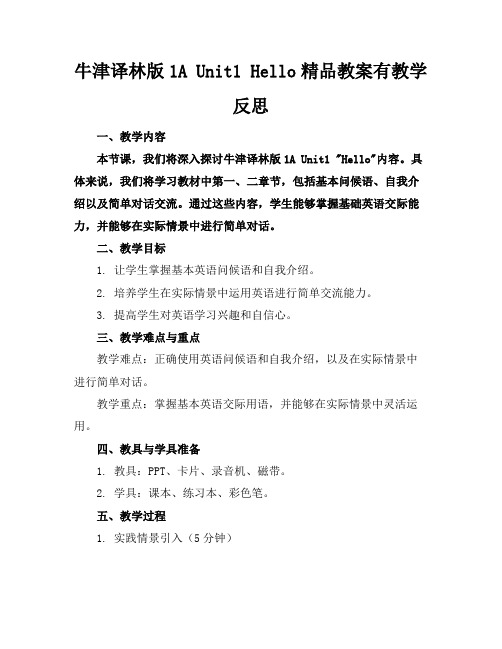
牛津译林版1A Unit1 Hello精品教案有教学反思一、教学内容本节课,我们将深入探讨牛津译林版1A Unit1 "Hello"内容。
具体来说,我们将学习教材中第一、二章节,包括基本问候语、自我介绍以及简单对话交流。
通过这些内容,学生能够掌握基础英语交际能力,并能够在实际情景中进行简单对话。
二、教学目标1. 让学生掌握基本英语问候语和自我介绍。
2. 培养学生在实际情景中运用英语进行简单交流能力。
3. 提高学生对英语学习兴趣和自信心。
三、教学难点与重点教学难点:正确使用英语问候语和自我介绍,以及在实际情景中进行简单对话。
教学重点:掌握基本英语交际用语,并能够在实际情景中灵活运用。
四、教具与学具准备1. 教具:PPT、卡片、录音机、磁带。
2. 学具:课本、练习本、彩色笔。
五、教学过程1. 实践情景引入(5分钟)我将通过扮演不同角色,模拟日常问候场景,让学生在观察和模仿中自然进入英语学习状态。
2. 例题讲解(10分钟)通过PPT展示教材中例句,详细讲解问候语和自我介绍表达方式。
引导学生关注并模仿标准发音。
3. 随堂练习(10分钟)分组练习,让学生相互问候,并进行自我介绍。
我将巡回指导,纠正发音错误,提高学生交流能力。
4. 小组活动(10分钟)学生分组,每组设计一个简单对话场景,进行角色扮演。
我将观察学生表现,及时给予反馈和鼓励。
我将带领学生回顾本节课所学内容,巩固知识点。
提供一些拓展性练习,让学生在课后进行自我提升。
六、板书设计1. 在黑板上列出本节课重点词汇和句型。
2. 用不同颜色标注易错点和注意事项。
七、作业设计1. 作业题目:编写一个简短对话,包括至少两个问候语和一个自我介绍。
根据教材录音,模仿并朗读所学内容。
2. 答案:示例对话:A: Hi, my name is Tom. How are you? B: I'm fine, thank you. And you?录音模仿:根据教材磁带进行模仿。
牛津译林版1AUnit1Hello教案有教学反思

牛津译林版1A Unit1 Hello教案有教学反思一、教学内容本节课选自牛津译林版1A Unit1 Hello,主要内容包括:教材第1页和第2页的对话,涉及到日常问候语、自我介绍和他人介绍等交际用语。
具体章节内容为:Hello, I'm / Hi, I'm Nice to meet you. / Nice to meet you, too. 学习并掌握这些基本交际用语,为今后的英语学习打下基础。
二、教学目标1. 能够听懂、会说、会读日常问候语和自我介绍。
2. 能够运用所学知识进行简单的人际交流。
三、教学难点与重点重点:日常问候语和自我介绍的表达方式。
难点:如何将所学知识运用到实际情景中进行交流。
四、教具与学具准备教具:多媒体课件、磁带、录音机、卡片。
学具:课本、练习本、彩色笔。
五、教学过程1. 导入:通过播放英文歌曲《Hello Song》,营造轻松愉快的课堂氛围,吸引学生的注意力。
2. 情景引入:教师展示一张卡通人物图片,用英文进行自我介绍,如:“Hello, I'm Mr Cat. Nice to meet you.”引导学生模仿。
3. 例题讲解:教师呈现教材第1页的对话,引导学生学习日常问候语和自我介绍的表达方式,并进行角色扮演。
4. 随堂练习:学生两人一组,用所学知识进行问候和自我介绍,教师巡回指导。
6. 课堂活动:组织“自我介绍接龙”游戏,学生依次用英文介绍自己,巩固所学知识。
六、板书设计1. Unit1 Hello2. 内容:Hello, I'm / Hi, I'mNice to meet you. / Nice to meet you, too.七、作业设计1. 作业题目:和家人或朋友用英文进行问候和自我介绍。
2. 答案:Selfintroduction:Hello, my name is I am years old. I like八、课后反思及拓展延伸1. 反思:本节课通过情景引入、例题讲解、随堂练习等方式,使学生掌握了日常问候语和自我介绍的表达方式。
江苏省徐州市译林牛津版高中英语必修一Unit1 Project 教案1

What would the club do?
How does it help members achieve their goals?
How does it attract new members?
Discuss in pairs and try to express themselves.
课外作业
1. Find out the sentences with attributive clauses.(找出文中的定语从句)
2. Preview the language points and underline them on the textbooks.
教 学 小 结
When (when was it started)
Why (the reason why it was started)
3.Ask students to read the second passage and find out as much information as they can about it.
备课时间
2017年9月21日
编写:
上课时间
第周周月日
班级节次
课题
Module 1 Unit 1 Project (1)
总课时数
第节
教学目标
1.To help the students get some information about after-school activities and school clubs
牛津译林版1AUnit1Hello教案有教学反思

牛津译林版1AUnit1Hello教案有教学反思一、教学内容二、教学目标1. 让学生掌握基本的问候语,如“Hello”、“Hi”、“Good morning”等,并能灵活运用。
2. 使学生学会用英语进行自我介绍,如“My name is”、“I'm”等。
3. 培养学生的英语听说能力,激发他们对英语学习的兴趣。
三、教学难点与重点1. 教学难点:正确使用问候语和自我介绍的表达方式。
2. 教学重点:基本的问候语和自我介绍的表达方式。
四、教具与学具准备1. 教具:教材、录音机、磁带、卡片、黑板。
2. 学具:练习本、铅笔、橡皮。
五、教学过程1. 实践情景引入:教师扮演不同角色,模拟日常生活中的问候场景,引导学生模仿并练习。
2. 例题讲解:教师讲解教材中的例题,解释问候语和自我介绍的表达方式。
b. Hi, I'm Wang Fang. And you?(嗨,我是王芳。
你呢?)3. 随堂练习:学生分角色练习问候和自我介绍,教师纠正发音和表达错误。
4. 小组活动:学生分成小组,用所学内容进行问候和自我介绍,互相纠正错误。
六、板书设计1. Unit 1 Hello2. 内容:a. Greetings(问候语): Hello, Hi, Good morning, Good afternoon, Good eveningb. Introducing yourself(自我介绍): My name is, I'm七、作业设计1. 作业题目:请用英语编写一段关于问候和自我介绍的对话。
答案示例:A: Hi, my name is Zhang Lei. I'm 12 years old. And you?B: Hello, I'm Li Na. I'm 13 years old. Nice to meet you!2. 作业要求:内容完整,表达清晰,注意语法和标点。
八、课后反思及拓展延伸1. 教学反思:本节课通过实践情景引入、例题讲解、随堂练习等方式,使学生掌握了基本的问候语和自我介绍的表达方式。
英语牛津译林1unit1精品教案(第2讲)
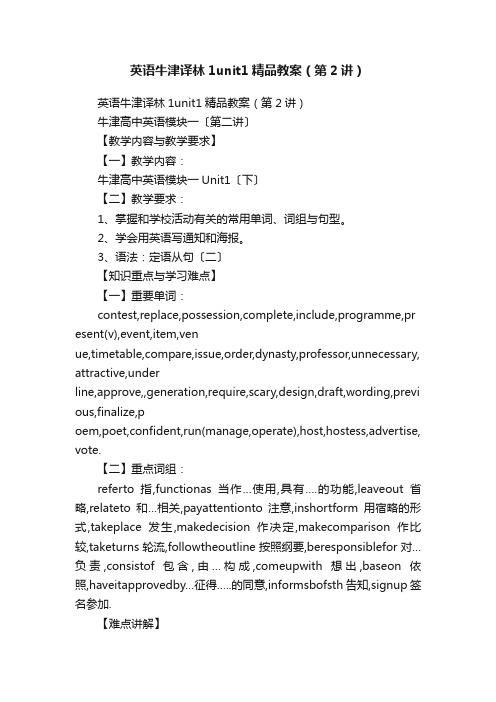
英语牛津译林1unit1精品教案(第2讲)英语牛津译林1unit1精品教案(第2讲)牛津高中英语模块一〔第二讲〕【教学内容与教学要求】【一】教学内容:牛津高中英语模块一Unit1〔下〕【二】教学要求:1、掌握和学校活动有关的常用单词、词组与句型。
2、学会用英语写通知和海报。
3、语法:定语从句〔二〕【知识重点与学习难点】【一】重要单词:contest,replace,possession,complete,include,programme,pr esent(v),event,item,venue,timetable,compare,issue,order,dynasty,professor,unnecessary, attractive,underline,approve,,generation,require,scary,design,draft,wording,previ ous,finalize,poem,poet,confident,run(manage,operate),host,hostess,advertise, vote.【二】重点词组:referto指,functionas当作…使用,具有….的功能,leaveout省略,relateto和…相关,payattentionto注意,inshortform用宿略的形式,takeplace发生,makedecision作决定,makecomparison作比较,taketurns轮流,followtheoutline按照纲要,beresponsiblefor对…负责,consistof包含,由…构成,comeupwith想出,baseon依照,haveitapprovedby…征得…..的同意,informsbofsth告知,signup签名参加.【难点讲解】1.Ihavetodomyhomeworkinaplacethathasdesksandchairs.我必须在一个有课桌椅的地方做家庭作业。
英语ⅰ译林牛津版unit1第一课时教案

英语ⅰ译林牛津版unit1第一课时教案Teachinggoals1.TargetlanguageImportantwordsandexpressions:low-rise,locker,atease2.AbilitygoalsEnablethestudentstocomparejuniorschoollifewithhighschoo llife.3.LearningabilitygoalsHelpthestudentslearnhowtocomparejuniorschoollifewithhig hschoollife.Teachingimportant&difficultpointsLearntocomparejuniorschoollifewithhighschoollife. TeachingmethodsDiscussion.TeachingaidsAcomputerandaprojector.TeachingproceduresStepⅠFreeTalkMakeaself-introductionandtalkaboutjuniorschoollifewitht hestudents.T:Hello,everyone.WelcometotheseniorhighEnglishclass.I'm ××.IhavebeenhereteachingEnglishsinceIgraduatedfrom××Universitymorethan10yearsago.Therefore,I'vemadealotoffriend s.NowI'mverygladtolearnEnglishtogetherwithyouthisyearandI'm surewe'llsoonbecomefriends,too.Nowyou'vejustfinishedyourjun iorschoollifeandareabouttoenteranewperiodinyourstudies.Doyo ufeelnervous?SI:Notatall.I'vemadesomepreparationsbeforeIcamehere.S2:Alittle.ThenewschoolisquitedifferentfromtheoneIwasin .S3:Yes,Idofeelnervous.Everythinghereisnewandstrangetome .S4:No.Idon'tfeelnervous.BecauseI'msureIcandomyschoolwor kbetterhere.T:Highschooltimeisveryimportantandoftenconsideredasgold entimeinourlife.However,someofyoumayfeeluncomfortablewhenfi rstcamehere.Whatdoyouthinkyoucandotoovercomethesedifficulti es?S5:Ithinkwecantrytorelaxourselvesbymakingasmanyfriendsa spossibleanddoingmoreactivities.S6:Therearereallysomedifferencesbetweenthelifeinjuniora ndhighschools.Weshouldadjustourselvestothenewenvironmentass oonaspossible.Ifwehavedifficulties,wecanaskforhelpfromclass matesandteachers.T:Well,whatarethedifferencesdoyouthinkbetweenthelifeinj uniorandhighschoolsare?Haveyoufoundsome?S7.YesFirsttherearemorestudentsherefromdifferentplaces. Inmyjuniorschool,studentswereallfromthesametown,andtherewer eonly30studentsinmyoldclass.T:Well,canyoutellussomethingaboutyourselfandyourschool?S7:I'mfromXMiddleSchoolMynameisS7.Thereisonlyathree-sto reybuildinginmyjuniorschool.Therewereabout500studentsthere. Andthestudents'dormitoryisnotbigenoughtoholdallthestudents. Asmyhomeisnotfarawayfromtheschool,Ihadtogobackhomeeveryday.T:Nowyouneedn'tgobackhomeeveryday.Butwouldyoumissyoupar ents?S7:Ofcourse.ButI'lltrytoovercomemyfeelings.T:Good.Anyotherdifferences?S8:Yes.We'llhavemoresubjectsinhighschoolandthickbooks.M aybetheyaremoredifficulttolearn.T:Don'tworry.Bothjuniorandhighschoolstudyareforagoodfou ndationofallsubjects.Aslongasyouworkhard,I'msureyoucanbebet ter.S9:Ifoundtherearemoreandhigherbuildingshere.Andmorebeau tifultoo.Inourschool,thereisonlyoneoldfive-storeybuilding.T:Whichschooldoyoucomefrom?Canyoutellussomethingaboutyourschoollifethere?S9:Icamefrom×middleschool.Itisasmallbutbeautifulschoolwithmountainsallar ound.Welivedattheschooldorms.Weusedtoclimbthemountainattheb ackoftheschoolafterclassandwereadandplayedthere.Weusedtopla ybasketballintheafternoonbuthadtogotoclassroomsforone-hours elf-study.T:Soundsinteresting.Anyway,anewschoolandnewstudentbodyi sagreatopportunitytolearnaboutpeople,placesandcultures.Iwis heveryoneherecanmakemanyfriendsandgetgreatsuccessinyourscho olworkintheseyears.StepⅡWelcometotheunitLookatthepicturesandtalkaboutdifferenthighschoollives.T:Well,boysandgirls,whenwespeakofschoollife,whichEnglis hwordscanyouthinkof?pleaselookatsomepicturesfirst.Ss:(joys;sorrows;dreams;discoveries;failures;tears;succ esses;challenges;excitement)T:We'vestudiedEnglishforthreeormoreyears.WhatistheUKsch oollifelike?HowdifferentisitfromthatinChina?Pleaselookatthe followingpictures.TheyshowsomepartsofhighschoolintheUK.What canyouseeinthepictures?Whatarethedifferencesbetweenschoolsi nChinaandintheUK.?T:Asweallknow,therearedifferencesbetweenschoollivesinju niorandhighschools.Sotheremustbedifferencesindifferentcultu res.Someofusmustbeeagertoknowwhattheschoollifeinothercountr iesarelike.Forexample,we'vestudiedEnglishforthreeormoreyear s,whatistheUKschoollifelike?HowdifferentisitfrominChina?You know,therearemanyfamousschoolsanduniversitiesintheUK.Today, we'llpickupthissubject.NowreadtheinstructionsinWelcometothe unitonpage1andfocusonthepicturesindividually.Askthestudents totalkaboutthepictures.T:Whatcanyouseeinthepictures?Whatarethedifferencesbetwe enschoolsinChinaandintheUK.S1:InPictureI-2,wecanseeverylow-risehousesandhugecampus .TheyareverydifferentfromthoseinChina.InChina,weusuallyhave largebuildingsandcampustomakesurestudentshaveenoughspacetos tudyinandplayin.S2:InPicture3-4,wecanseelockersforeachstudentoutsidethe classroom.InChina,weoftenhavesomelockersineverybedroom.S3:InPicture5-6,wecanseealargerclassroomwithfewerstuden tsinit.Thestudentssitintwolinesandfacetoface.Thestudentsare puttinguptheirhandseagerlytoanswertheteacher'squestions.InC hina,wealwayshaveafullclassroomwithstudentssittinginseveral linesfacingtheblackboardAndinmostcases,studentsarenotsoeagertoanswertheteachers'questions,especiallyhighmiddleschoolst udents.S4:InPicture7-8,twostudentsarediscussingsomethingwithth eirteacher.TheylookquiteateaseWiththeirteacherandlikefriend s.ItissimilarinChina,Nowadays,lotsofteachersandstudentshave establishedagoodrelationshipwitheachother.Theyrespecteachot herandtrytogainabetterunderstandingofeachother.T:Therearecertainlymanydifferencesbetweentheschoollives inChinaandintheUK,asweallcanseeclearlyfromthepictures.Doyou knowofanyotherdifferences?S5:Certainly.IheardthestudentsintheUKcanchoosewhatevers ubjecttheylike.S6:AndtheyarescoredA,B,C,DandEforeverysubjecttheychoose insteadof100points,150points,etc,suchasinChinaorotherAsianc ountries.T:Also,studentsintheUKhavedifferentschoolactivities.For example,theyorganizeschoolclubs,designpostersordovolunteerw ork.InChina,wealsohavemanyschoolactivities.Whatkindofschool activitiesdoyouenjoy?S7:Ienjoyplayingbasketballafterschool.S8:Ipreferdrawing.S9:Ilikeplayingchess.T:Withoutvarietiesofschoolactivities,schoollifewouldbeb oring.Mostofyoumusthavedrawnapictureofwhathighschoollifewou ldbelikeinyourmindbeforeyoucamehere.Nowwho'dliketoshareyour dreamschoollifewithus?S10:Mydreamschoollifeislikethis:therearemanyfriendlyand knowledgeableteachers;classmatesgetalongwellwitheachother;w estudy,play,singanddancetogether;wehaveparties,etc.Allinall ,I'mhappywitheverythingandeveryonehere.S11:Mydreamschoollifewouldbelikethis:Instudy,Iwillworkh ardertomakegreatprogressineverysubject;Iwilltrytodomorespor tstomakemestronger;Iwillbeabletolearntoplaycomputergames,et c....T:Justaswhatthefourpicturesshow,differencesdoexistbetwe enhighschoolsinourcountryandintheUK.Thereareofcourse,manyma sonsforsuchphenomena.Whatdoyouthinkthereasonsare?S1:Ithinkit'smainlybecausewebelongtodifferentcultures.B othChinaandtheUKhavealonghistoryofcivilizationamongwhichdif ferentschoolsystemsdeveloped.Itisnowonderwehavedifferentsch oollives.S2:Iquiteagreewithyou.Chinahasdifferentculturalandeduca tionalbackgroundfromthatoftheUK,sotherewillbedifferences.S$:ChinaandtheUKhavedifferent,traditionsineducationands choolsystems.Ibelieveeachhasadvantagesanddisadvantages.StepⅢHomeworkT:Studentsindifferentcountrieslearndifferentlyandhavedi fferentschoollifeexperiences.Idohopeyou'llhaveagreatexperie ncehere.Afterclass,1.Trytomakeacarefulplanforyourhighschoolstudy.2.PreviewtheReading.。
牛津译林版1AUnit1Hello教案有教学反思

牛津译林版1AUnit1Hello教案有教学反思一、教学内容本节课选自牛津译林版1AUnit1“Hello”,主要内容包括:教材第1页的图片和对话、单词卡片,以及第2页的活动1和活动2。
详细内容为:通过图片和对话学习单词“hello”、“goode”、“morning”、“afternoon”、“evening”,以及简单自我介绍的表达方式。
二、教学目标1. 能够听懂、会说、会读单词“hello”、“goode”、“morning”、“afternoon”、“evening”。
2. 能够用简单的英语进行自我介绍,例如:“Hello, my name is”。
3. 能够在真实场景中运用所学单词和句子进行问候和告别。
三、教学难点与重点教学难点:单词“morning”、“afternoon”、“evening”的发音和拼写。
教学重点:单词“hello”、“goode”以及自我介绍句型的正确运用。
四、教具与学具准备教师准备:单词卡片、图片、磁带或光盘、教学录音机、黑板、粉笔。
学生准备:课本、练习本、彩色笔。
五、教学过程1. 导入:教师播放英语歌曲“Hello Song”,引导学生跟唱,营造轻松愉快的英语学习氛围。
2. 呈现:教师展示教材第1页的图片和对话,引导学生学习单词“hello”、“goode”、“morning”、“afternoon”、“evening”。
3. 实践:教师组织学生进行小组活动,用所学单词和句型进行问候和告别练习。
4. 课堂讲解:教师选取教材第2页活动1的例句,讲解单词和句型的用法。
5. 随堂练习:学生完成教材第2页活动2,教师进行个别指导。
六、板书设计1. 牛津译林版1AUnit1“Hello”2. 单词:hello、goode、morning、afternoon、evening3. 句型:Hello, my name is七、作业设计1. 作业题目:根据所学内容,编写一段自我介绍,包括问候和告别。
江苏省徐州市译林牛津版高中英语必修一Unit1 Project 教案2

select sb as
.
Write 6 attributive clauses on their exercise books.
Take notes.
Know about the differences between“in charge of”and“in the charge of”.
.教
学
二次备课
教学过程设计
★5.require vt. requirement n.
require sb to do sth
require that …(should )+do
(类似的动词还有:suggest, insist, demand, order, etc.)
(sth)require/want/need doing/to be done
run out of 用完…
2.approve vi.赞成,同意(of)
vt.批准;通过(计划等);认可
disprove/approval/approving/approvingly
★3.(sb be)in charge of (sth)主管负责
(sth)be in the charge of (sb)
教学辅助手段
多媒体
专用教室
教学过程设计
教
学
二次备课
Step 1 Greetings
Step 2.Check the homework
1.Ask some students to write the attributive clauses on the blackboard.
2.Writedownsome language points
【牛津译林版】高中英语 Unit1 教学设计全文

可编辑修改精选全文完整版单元:Unit 1 The world of our senses板块:Grammar and usage课堂设计指导思想:本课语法为名词性从句。
教学目的为帮助学生了解什么是名词性从句;学会连词that,if,whether的正确使用。
语法课的设计应摒弃教师一讲到底,罗列语法规则的陈旧教学方式,把语法的运用放置于情景中。
这样学生就会身临其境学习语法,生动、有趣,教学效果好。
Teachin g aims:1. Make sure the students understand what the noun clauses are.2. Students should know the different use of noun clauses.3. Learn to use conjunctions: that, if/whether.Teaching procedures:Step1. Introduction to noun clauses (pp t 4-5)What is noun?What is the use of noun?What is noun clause?(by reading some sentences):•At lunch, the weatherman reported that the mist would become a thick fog in the afternoon.•She wondered if the buses would still be running.•The truth is that the fog is too thick for the bus to run that far.•What surprised me most was that the old man couldn’t see anything.【设计说明】从课文中挑选出四句名词性从句,经过两课时的课文阅读及语言点教学,学生对这些句型结构已有清晰的理解,以此导入名词性从句的教学显得比较自然。
牛津译林版高中英语必修1牛津译林版高中英语必修1Unit1__Period__2教案

Unit1 Period 2参考教案ReadingTeaching objectives1. Target languagea. 重点词汇attend, earn, respect, achieve, grade, literature, average, challenging, lunchtime, e-mail, extra, cooking, prepare, drop, Spanish, German, woodwork, miss, dessert, field, experienceb. 重点句子This means I could ... P2I found the homework was not ... but ... P2I was very lucky to ... and ... P32. Ability objectivesEnable the students to learn to talk about school life and identify the differences between the school lives in the UK and in China.3. Learning ability objectivesHelp the students learn how to talk about school life.Teaching important & difficult pointsLearn about the school life in the UK.Teaching methodsDiscussion and task-based activities.Teaching aidsA computer and a projector.Teaching procedures & waysStep I Lead-inCheck the homework.T: In the last period, we learned that there are great differences between the school lives in the UK and in China. UK has a long history in education and its publicschools are very famous in the world. Many children in the UK, even those from the royal families would go to the public schools. Why? Today, we’ll go to the UK schools to have a look.Step II ReadingActivity 1 SkimmingAsk the students to read the text quickly to find the answers to the questions in Part A. T: Next we’ll read an article from a school magazine written by an exchange student named Wei Hua. After studying in the UK for one year, she gives us a brief but clear description about what school life in the UK is like from her own experience. Now read the text quickly and answer the questions on page 2. For this, try to focus on and identify the most important information in the text.Check the answers.T: It’s not so difficult for you to find the answers to the questions. But for this, I do have some questions for you: first, have you noticed where the answers to these questions lie in the text?S: They are either at the beginning or the end of certain paragraphs.T: Second, in what way did you find the answers?S1: I read through the whole article and found the answers.S2: For Question 1, I only read the first sentences of the first paragraph.S3: I found the words “my class teacher” first, and then the answer to Question 2.S4: First, I found the paragraph talking about “Woodwork class”, and then I found the answer to Question 3.T: In doing Part A and answering the questions, we can reach the following conclusion, that is, it’s not necessary to read an article word by word or senten ce by sentence to finish certain tasks. This is what we called “reading strategy”. In this unit, two reading strategies are introduced, which are considered as two basic reading skills and often used by many people. Now read the “strategy box” and find the true meaning of them and when and how to use the skills and then try to finish the following form.Show the following.Sample answers:Activity 2 Scanning1. Ask the students to reread the passage and complete Parts C1 and C2 on page 4. T: Som etimes you want to find information quickly. In this case, you don’t read every sentence. Instead, you scan the material —you look quickly for the important words. To do this, have a question in your mind. Then run your finger down the page until the answ er “jumps out” at you. Don’t read any more than necessary in order to answer your questions. Now, please read the text again and try to finish Parts C1 and C2.Then check the answers.2. Ask the students to go through the article again and find out what topics are covered in it.T: Some parts of school life in the UK are mentioned in the article. Now please find out what specific aspects are mentioned and then try to fill in the form on the screen.Show the form.Sample answers:school hours; assembly; teachers; students; classes; homework; subjects; school activities; Woodwork class; food; free timeStep III After-readingActivity 1 Getting the Main Idea1. Parts of the text and main idea for each partT: Next please find out how many parts the text can be divided into and what the main idea for each part is.Sample answers:Part I(Para 1): Wei Hua was happy with her experience in the UK.Part II (Paras 2-7)): Different aspects of school life in the UK.Part III (Para 8): Wei Hua’s feeling and hope.2. Main idea of the textT: What’s the main idea of the text?S: The text is about what school life in the UK is like. In the text, Wei Hua described several aspects of the school life in the UK, including the school hours, school assembly, teachers, classes, homework, subjects, school activities, Woodwork class, food and her free time.T: How do you like the school life Wei Hua described in the text?S1: I found the school life in the UK is more relaxed than that in China. For example, they have less school hours than us. We Chinese students have to study at least ten hours each day. As I know, some students of Senior three spend even more hours on study.S2: I think the students in the UK are free in choosing the subjects. They can drop the subjects they don’t like. But it is quite different in China. We have to study the same subjects whether we like them or not.S3: Also I think they have some lessons which have much to do with daily life, suchas cooking, Woodwork class.Activity 2 Guessing Meaning from ContextT: Sometimes you do not need to look up the meanings of all new words in a dictionary. You can often guess the meanings of many words from the context.Now read the instructions in Part D and try to finish the exercise.Show the reference materials about How to Guessing Meaning from Context. (见附件) Check the answers.Activity 3 Discussing the Reading1.ExplanationGive necessary help if the students have any difficulties in understanding the text.T: From the article we have learned a lot about the school life in the UK. There are really many differences between school life in the UK and in China. Do you have any difficulties in understanding the text?Some sample language difficulties and explanation:(1)How to understand the sentence “Going to a British high school for one year wasa very enjoyable and exciting experience for me?” Can you give us some moreexamples?Explanation: Here “Going to a British high school” is a gerund phrase used as subject. Examples:— What do you think made Mary so upset?— Losing her new bicycle.It’s no use buying a lot of books without reading them.Studying in high school is an important period in one’s life.(2) I sat next to a girl whose name was Diane.Explanation: Here “whose name was Diane” was used as an attributive modifying the word “girl”.Examples: Here comes Smith whose father is a famous scientist.The man whose umbrella you took is very angry about it.The girl whose work got the prize is the youngest in her class.(3) He also told us that the best way to earn respect from the school was to work hardand achieve high grades.Explanation: “to earn respect” is used as an attributive modifying the word “way” and “to work hard” is used as a predicative.Examples: He is always the first one to get up.Every morning she would give him breakfast in bed and bring him thepapers to read.The roof fell before he had time to dash into the room to save his baby.Then there are always people to talk to if you feel like a chat.The best treatment for fatness is to reduce the internal fat.We weren’t allowed to stop him. All we could do was to watch him.Either you or the headmaster is to hand out the prizes to these giftedstudents at the meeting.(4) Though it didn’t’ look like a table when it was finished, I still liked it very much. Exp lanation: “Though” is a conjunction, which means “in spite of the fact that”. When “though” is used as a conjunction, it can’t be used together with “but”. Examples: Though times were changed, Bursley was still Bursley.Though he was going to Winnipeg, he was in no hurry.It is right for us to go, though I left all for George to decide.Harvest comes not every day, though it comes every year.The speech is good, though it could be better.Though we be poor, we will still be happy.2. Recognizing the writing purpose, style and techniquesT: What is the purpose of the writing?S: In the article, Wei Hua gives us a brief but clear description about what school life in the UK is like from her own experience. I think the purpose of the writing is to introduce us something about British school system and make us identify the differences between the school life in different cultures.T: What do you think the writing style and techniques of the text are?S: This is a description. The writer shows us a vivid picture of what the school life in the UK is like from her own experience, that is, the write adopts the first personwriting method making the readers feel like that’s just their own experiences.3.Summarizing: moral aspects of the textT: N ow that we’ve al ready had a clear understanding of the text and known something about the school life in the UK, we find great differences exist in different cultures.As for Chinese students, we are used to getting up early in the morning, hurrying for breakfast, listening to the teachers attentively in the class, doing more homework after school and having less school activities, etc. We might have heard some say that Chinese students lack of creativity, imagination, such and such.Anyway, there are advantages and disadvantages of the school systems and lives in both cultures. We must on one hand, face the reality and follow the rules and traditions of us Chinese, on the other, we should know more about foreign cultures and learn the better parts from them.4. PracticeAsk the students to complete Parts D on page 4. Then check the answers.Step IV Homework1. Write an article about the differences between high schools in the UK and in China.2. Find more information about different school lives in different cultures.。
译林牛津版高一英语必修1全套教案(共47张)
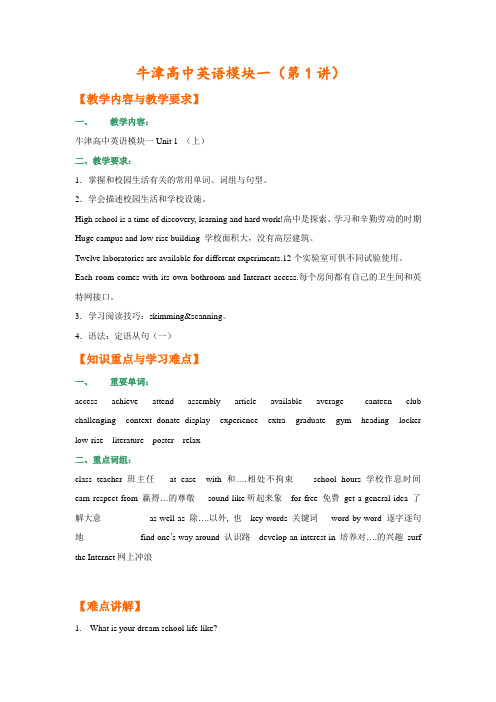
牛津高中英语模块一(第1讲)【教学内容与教学要求】一、教学内容:牛津高中英语模块一Unit 1 (上)二、教学要求:1.掌握和校园生活有关的常用单词、词组与句型。
2.学会描述校园生活和学校设施。
High school is a time of discovery, learning and hard work!高中是探索、学习和辛勤劳动的时期Huge campus and low-rise building 学校面积大,没有高层建筑。
Twelve laboratories are available for different experiments.12个实验室可供不同试验使用。
Each room comes with its own bothroom and Internet access.每个房间都有自己的卫生间和英特网接口。
3.学习阅读技巧:skimming&scanning。
4.语法:定语从句(一)【知识重点与学习难点】一、重要单词:access achieve attend assembly article available average canteen club challenging context donate display experience extra graduate gym heading locker low-rise literature poster relax二、重点词组:class teacher 班主任at ease with 和….相处不拘束school hours学校作息时间earn respect from 赢得…的尊敬sound like听起来象for free 免费get a general idea 了解大意as well as 除….以外, 也key words 关键词word by word 逐字逐句地find one’s way around 认识路develop an interest in 培养对….的兴趣surf the Internet网上冲浪【难点讲解】1.What is your dream school life like?你理想中的学校生活是什么样子?这里dream表示心目中最理想的. 如dream team (梦之队)。
译林版牛津A全册教案

3.Develop the Ss’ability of communication.
7.Ask Ss to make some sentences by using the useful phrases.
e.g. We are back at school.
There are a lot of students in the school.
Theoffice is on the second floor.
4.Listen to the tape for 2 times and find out the answers.
Q: How many classrooms are there?
How many reading rooms?
5.Ask Ss to answer the questions.
6.Open the books and explain the dialogue.
Ss: Yes.
T: Can you guess where is it?
Ss:公园。
T: Yes. It’s a garden.
2). Readafter the T. garden, garden是公园.
3). Ss imitate, read together and readone by one.
……
六、教后感
七、教案过程(应有教案过程的一般环节,如预习检测、复习训练、目标提示、内容新授、教案小结、作业布置等,并且必须有内容设计、训练设计、方法设计。)
- 1、下载文档前请自行甄别文档内容的完整性,平台不提供额外的编辑、内容补充、找答案等附加服务。
- 2、"仅部分预览"的文档,不可在线预览部分如存在完整性等问题,可反馈申请退款(可完整预览的文档不适用该条件!)。
- 3、如文档侵犯您的权益,请联系客服反馈,我们会尽快为您处理(人工客服工作时间:9:00-18:30)。
Pair work.
两人一组,一起来演演看。
11. play a game: random choice
T choose ss by seldom.
Ask them to act.
随机点名,请他们配合着来演演看。
小 学 英 语 备 课 用 笺
●课题 Unit1 I’m liu tao●使用 1 课时 ●总第 2 课时
学习I’m 和Miss
学生齐读。
T-s1: hello, I’m Miss G.
But I don’t know your name.
Can youintroduceyourself useI’m?
但是老师还不知道你的名字。
你能用I’m来介绍下你的名字吗?
S1:…
T: good! (给与奖励)
T: who can? (要求要举手)
2.能听懂、会说人物姓名Liu Tao Yang Ling
教学难点:能用I’m 做自我介绍
●教学具准备及辅助活动
图片,多媒体
●主要板书计划
Unit 1 Hello
Hi/Hello I’m Liu Tao
Yang Ling
●作业设计、安排
课内ห้องสมุดไป่ตู้
练习 Hello/ Hi I’m…
课外
让学生和家长问好,以巩固所学的Hello,Hi。
S1-s2: hi!
S2-s1: hi!
3. t-s1: hi!
S1:hi!
t-s2: hello!
引导学生也用hello来回答
学习hello!
学生齐读。
4.用hi hello与同学随机打招呼。
并进行pair work, 同桌间练习
请同学来进行表演。
及时表扬。
5. t: (自我介绍)Hello! I’m Miss G.
图片,多媒体
●主要板书计划
Unit 1 Hello
I’m... Su Hai
Hi/Hello Wang Bing
Liu tao
Yang ling
●作业设计、安排
课内
Pair work
课外
用I’m向父母介绍自己,并将新朋友介绍给父母
●教学过程
教学随笔
Step1
1. greetings
t: hi!
Ss: hi
刚才动画片里是怎么说的?
S:hello,I’m liu tao.
S: hi,I’m yang ling.
9. t: listen carefully,and repeat
仔细听,让我们一起来模仿下语音语调。
Pair work.
两人一组一起来读读看。
10.t: look carefully, and copy.
复习 stand up.
演练3遍。
Step2 presentation
1.t: do you remember my name ?
复习miss
2.t:I’m sorry,Ican’t remember your name.
can you introduce yourself?
复习 I’m
3.play a game: pass the flower(击鼓传花)
让我们来看电视,找找看,故事里的这两个人叫什么?
Watch the cartoon of picture 1.
Find out the answer
学习 liu tao and yang ling.
8. t: how can you find the answer the answer?
你是怎么找到答案的?
4.play a game: I have a long train.
T-s1: hello,I’m…
T: hello!
Ss: hello!
T: class begings.
Who can remember how to say?
考考大家,我们该说什么呢?
S1 tell the answer to the teacher with low voice.
学生悄悄地告诉老师,选出记性好,认真上课的同学奖励。
小 学 英 语 备 课 用 笺
●课题 Unit1 Hello ●使用 1 课时 ●总第 1 课时
●教学目标
1.能听懂、会说日常问候语Hello!Hi!I’m 要求发音准确、语调自然。
2.能听懂、会说人物姓名Liu Tao Yang Ling
3. 能听懂 Miss, Stand up.
●教学重点难点
教学重点:1.能听懂、会说日常问候语Hello!Hi!I’m 要求发音准确、语调自然。
●教学目标
1.会用Hi、hello和已经认识的同学打招呼。
2.认识人物 wang bing 和 su hai.
●教学重点难点
教学重点:1.会用Hi、hello和已经认识的同学打招呼。
2.认识人物 wang bing 和 su hai.
教学难点:对打招呼和自我介绍两种句型有意识的进行回答。
●教学具准备及辅助活动
T: hi!
Ss: hi!
Repeat 3 times
Step 2 presentation
1.T: Hi!
与学生打招呼,并热情的挥手。
引导同学也用Hi来回答。
T; hi!
Ss: hi!
学习hi!
学生齐读
2..t-s1:Hi!
S1: hi!
T: can you speak to s2? 你能用hi和你后面的同学打招呼吗?
●教学过程
教学随笔
Step1 Warm Up
T: hi, boys and girls.
Ss: hi。
T: 同学们,我们要开始上课了。大家要一起说stand up。起立。
学习stand up。
(t-an, s,d, stand)
(u, p, up)
T: class begins.
Ss: stand up.
Introduce yourself to the class.
进过了一天的学习生活,学生之间还并不认识,请学生自我介绍。
Play the music.
Ss pass the flower.
When music stops, the s who has the flower should introduce himself to the class.
Sn用I’m 进行介绍。
6. t: very good!
Now, can you use Hello/hi, I’m… tointroduce yourself?
谁能用完整的句子来进行自我介绍呢?
Ss:hello/hi,I’m…
7. t: look at the tv.
Let’s find out who are they?
